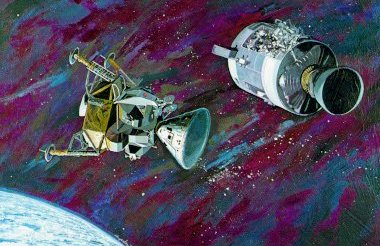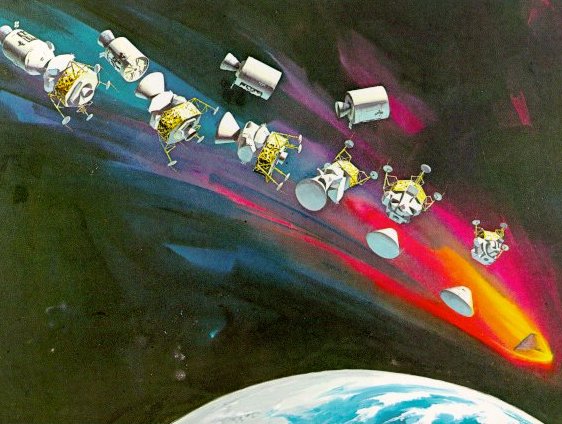| |
Time Travel Research Center © 2005 Cetin
BAL - GSM:+90 05366063183 - Turkey/Denizli
Apollo Expeditions to the Moon
CHAPTER 6
FIFTEEN MINUTES OF POWER LEFT
With only 15 minutes of power left in the CM, CapCom told us to make our
way into the LM. Fred and I quickly floated through the tunnel, leaving Jack
to perform the last chores in our forlorn and pitiful CM that had seemed
such a happy home less than two hours earlier. Fred said something that
strikes me as funny as I read it now: "Didn't think I'd be back so soon."
But nothing seemed funny in real time on that 13th of April, 1970.
| |
| Blast-gutted service module was set
adrift from the combined command module and lunar module just four hours
before Earth reentry. Mission Control had insisted on towing the wrecked
service module for 300,000 miles because its bulk protected the command
module's heat shield from the intense cold of space. The astronauts next
revived the long-dormant command module and prepared to leave their
lunar module lifeboat. |
There were many, many things to do. In the first place, did we have enough
consumables to get home? Fred started calculating, keeping in mind that the
LM was built for only a 45-hour lifetime, and we had to stretch that to 90.
He had some data from previous LMs in his book -- average rates of water
usage related to amperage level, rate of water needed for cooling. It turned
out that we had enough oxygen. The full LM descent tank alone would suffice,
and in addition, there were two ascent-engine oxygen tanks, and two
backpacks whose oxygen supply would never be used on the lunar surface. Two
emergency bottles on top of those packs had six or seven pounds each in them.
(At LM jettison, just before reentry, 28.5 pounds of oxygen remained, more
than half of what we started with.)
We had 2181 ampere hours in the LM batteries. We thought that was enough if
we turned off every electrical power device not absolutely necessary. We
could not count on the precious CM batteries, because they would be needed
for reentry after the LM was cast off. In fact, the ground carefully worked
out a procedure where we charged the CM batteries with LM power. As it
turned out, we reduced our energy consumption to a fifth of normal, which
resulted in our having 20 percent of our LM electrical power left when we
jettisoned Aquarius. We did have one electrical heart-stopper during the
mission. One of the CM batteries vented with such force that it momentarily
dropped off the line. We knew we were finished if we permanently lost that
battery.
| |
| The jettisoning of
elements during the critical last hours of the Apollo 13 mission is
shown in this sequence drawing. When the lifesaving LM was shoved off by
tunnel pressure about an hour before splashdown, everyone felt a surge
of sentiment as the magnificent craft peeled away. Its maker, Grumman,
later jokingly sent a bill for more than $400,000 to North American
Rockwell for "towing" the CSM 300,000 miles. |
|
|

